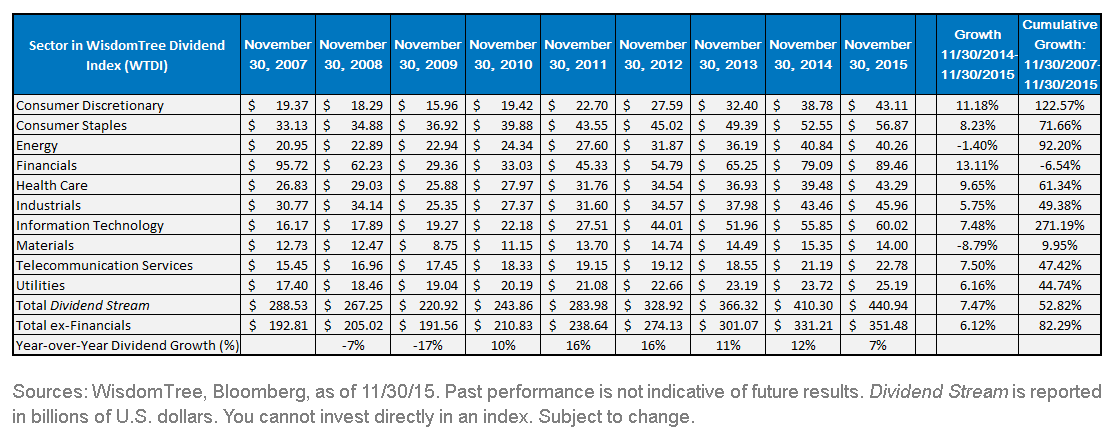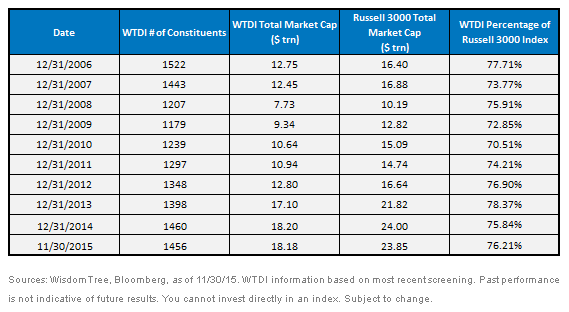Sixth Consecutive Year of Above Average Dividend Growth


 • New Record Dividend Stream: 2015 marks the sixth consecutive year of above-average dividend growth for the U.S. Dividend Stream. Although this was the first time in six years that dividend growth wasn’t in the double digits, the growth was still above the longer-term average of 5.6%, and 2015 marks a new high—over 53% above the mark set in 2007.2
• Tech Titan Growth: Information Technology sector dividends have grown a remarkable 270% since November 30, 2007. At the prior peak, this sector constituted only 5.6% of the Dividend Stream, whereas now it constitutes more than 13.5% and is the second-largest dividend-paying sector behind Financials.
• Financials Displayed Highest Growth: The sector has grown its dividends more than 13% since last year’s screening and has averaged more than 20% growth since hitting bottom in 2009. Despite the impressive growth since then, the sector’s dividends are still slightly below their 2007 highs, and Financials are the only sector whose Dividend Stream remains below its 2007 highs.
• Energy Dividends Relatively Flat: Overall, the sector saw a slight decline in dividends, which is impressive, considering the 37% decline in oil prices and 50% decline in the sector’s core earnings.3 Exxon remains the largest dividend payer in the U.S., with an indicated Dividend Stream of $12.2 billion, and actually grew its dividend by 5.80% over the period. Chevron, the second largest dividend payer in the sector, kept its dividend constant over the period, and ConocoPhillips, the third largest, raised its dividend by 1.37%. Heavily reliant as it is on the price of oil, we believe this sector will remain in focus this year as many try to determine an equilibrium price for oil.
Number of Dividend Payers
The November 30, 2015, rebalance screening showed that the Dividend Stream has grown, and one reason for that growth is an increased number of companies paying dividends. At each annual screening date the Index looks to incorporate dividend changes of existing constituents but also include new dividend-paying companies. Throughout the year companies may drop out of the Index as a result of dividend cancelation or other corporate actions such as mergers, acquisitions or even bankruptcy. The table below helps illustrate how these new dividend payers are continuing to be a very significant part of the Russell 3000 Index market cap.
WisdomTree Dividend Index (WTDI) Historical Trends
• New Record Dividend Stream: 2015 marks the sixth consecutive year of above-average dividend growth for the U.S. Dividend Stream. Although this was the first time in six years that dividend growth wasn’t in the double digits, the growth was still above the longer-term average of 5.6%, and 2015 marks a new high—over 53% above the mark set in 2007.2
• Tech Titan Growth: Information Technology sector dividends have grown a remarkable 270% since November 30, 2007. At the prior peak, this sector constituted only 5.6% of the Dividend Stream, whereas now it constitutes more than 13.5% and is the second-largest dividend-paying sector behind Financials.
• Financials Displayed Highest Growth: The sector has grown its dividends more than 13% since last year’s screening and has averaged more than 20% growth since hitting bottom in 2009. Despite the impressive growth since then, the sector’s dividends are still slightly below their 2007 highs, and Financials are the only sector whose Dividend Stream remains below its 2007 highs.
• Energy Dividends Relatively Flat: Overall, the sector saw a slight decline in dividends, which is impressive, considering the 37% decline in oil prices and 50% decline in the sector’s core earnings.3 Exxon remains the largest dividend payer in the U.S., with an indicated Dividend Stream of $12.2 billion, and actually grew its dividend by 5.80% over the period. Chevron, the second largest dividend payer in the sector, kept its dividend constant over the period, and ConocoPhillips, the third largest, raised its dividend by 1.37%. Heavily reliant as it is on the price of oil, we believe this sector will remain in focus this year as many try to determine an equilibrium price for oil.
Number of Dividend Payers
The November 30, 2015, rebalance screening showed that the Dividend Stream has grown, and one reason for that growth is an increased number of companies paying dividends. At each annual screening date the Index looks to incorporate dividend changes of existing constituents but also include new dividend-paying companies. Throughout the year companies may drop out of the Index as a result of dividend cancelation or other corporate actions such as mergers, acquisitions or even bankruptcy. The table below helps illustrate how these new dividend payers are continuing to be a very significant part of the Russell 3000 Index market cap.
WisdomTree Dividend Index (WTDI) Historical Trends
 • Over 90 Additions: There were over 90 additions to WTDI this year, and they contributed $8.6 billion to the Dividend Stream. Despite all the additions, the total number of constituents is still slightly below last year’s and WTDI’s prerecession highs. The two largest additions were Gilead Sciences and Vereit Incorporated, contributing $2.5 billion and $497 million, respectively.4
• A Large Majority of Constituents Exhibited Dividend Stream Growth: Excluding the additions, approximately 80% of the constituents remaining in the Index have increased their indicated Dividend Stream since last year’s screening. Such household names as Microsoft, Walt Disney, International Business Machines (IBM) and Apple were some of the leaders in the indicated Dividend Stream growth.5
Conclusion
WisdomTree interprets this year’s aggregate dividend growth of 7.5% as a very positive indicator of underlying market fundamentals. Even more impressive is the fact that this was the sixth consecutive year of above-average dividend growth. We take comfort in the fact that the overall valuations of dividend stocks have not become overly stretched as a result of this strong dividend growth, and believe future dividend growth could provide a notable foundation for potential future gains.
1The annual screening date is when each qualifying company’s indicated dividends per share are measured; the actual rebalancing transactions that adjust the Index to these new weights occur in December.
2Each calendar year mentioned refers to the November 30 screening date for that year.
3Sources: S&P, WisdomTree, 11/30/14–11/30/15. Decline in oil refers to spot price of West Texas Intermediate (WTI) Crude.
4Gilead Sciences’ and Vereit Incorporated’s projected rebalance weights in the WisdomTree Dividend Index are 0.56% and 0.11%, respectively.
5The projected rebalance weight of the mentioned companies in the WisdomTree Dividend Index are: Microsoft, 2.59%; Walt Disney, 0.49%; IBM, 1.14%; Apple, 2.61%.
• Over 90 Additions: There were over 90 additions to WTDI this year, and they contributed $8.6 billion to the Dividend Stream. Despite all the additions, the total number of constituents is still slightly below last year’s and WTDI’s prerecession highs. The two largest additions were Gilead Sciences and Vereit Incorporated, contributing $2.5 billion and $497 million, respectively.4
• A Large Majority of Constituents Exhibited Dividend Stream Growth: Excluding the additions, approximately 80% of the constituents remaining in the Index have increased their indicated Dividend Stream since last year’s screening. Such household names as Microsoft, Walt Disney, International Business Machines (IBM) and Apple were some of the leaders in the indicated Dividend Stream growth.5
Conclusion
WisdomTree interprets this year’s aggregate dividend growth of 7.5% as a very positive indicator of underlying market fundamentals. Even more impressive is the fact that this was the sixth consecutive year of above-average dividend growth. We take comfort in the fact that the overall valuations of dividend stocks have not become overly stretched as a result of this strong dividend growth, and believe future dividend growth could provide a notable foundation for potential future gains.
1The annual screening date is when each qualifying company’s indicated dividends per share are measured; the actual rebalancing transactions that adjust the Index to these new weights occur in December.
2Each calendar year mentioned refers to the November 30 screening date for that year.
3Sources: S&P, WisdomTree, 11/30/14–11/30/15. Decline in oil refers to spot price of West Texas Intermediate (WTI) Crude.
4Gilead Sciences’ and Vereit Incorporated’s projected rebalance weights in the WisdomTree Dividend Index are 0.56% and 0.11%, respectively.
5The projected rebalance weight of the mentioned companies in the WisdomTree Dividend Index are: Microsoft, 2.59%; Walt Disney, 0.49%; IBM, 1.14%; Apple, 2.61%.
Important Risks Related to this Article
Please keep in mind that high double-digit and/or triple-digit returns are highly unusual and cannot be sustained. Investors should also be aware that these returns were achieved primarily during favorable market conditions.
Dividends are not guaranteed, and a company’s future ability to pay dividends may be limited. A company currently paying dividends may cease paying dividends at any time.

Jeremy Schwartz has served as our Global Chief Investment Officer since November 2021 and leads WisdomTree’s investment strategy team in the construction of WisdomTree’s equity Indexes, quantitative active strategies and multi-asset Model Portfolios. Jeremy joined WisdomTree in May 2005 as a Senior Analyst, adding Deputy Director of Research to his responsibilities in February 2007. He served as Director of Research from October 2008 to October 2018 and as Global Head of Research from November 2018 to November 2021. Before joining WisdomTree, he was a head research assistant for Professor Jeremy Siegel and, in 2022, became his co-author on the sixth edition of the book Stocks for the Long Run. Jeremy is also co-author of the Financial Analysts Journal paper “What Happened to the Original Stocks in the S&P 500?” He received his B.S. in economics from The Wharton School of the University of Pennsylvania and hosts the Wharton Business Radio program Behind the Markets on SiriusXM 132. Jeremy is a member of the CFA Society of Philadelphia.

